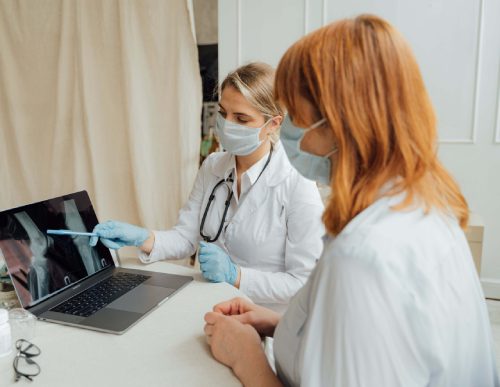Decoding Arthritis: Understanding the Causes of Joint Pain

Arthritis is a condition that affects 52.5 million Americans, with over 22.7 million experiencing activity limitations due to the disease. However, arthritis is not just a single disease but a way of referring to joint pain or joint disease. There are more than 100 different types of arthritis and related conditions. This blog aims to explore what causes pain from arthritis in the joints of the human body.
Understanding Arthritis and Joint Pain
At its core, arthritis is an inflammation of one or more of your joints. Pain, swelling, and stiffness are the primary symptoms affecting people of all ages, sexes, and races. The severity of arthritis can vary greatly; in some people, it's a mere inconvenience, while in others, it can cause debilitating pain.
The Mechanism of Pain in Arthritis
- Cartilage Deterioration: In osteoarthritis, the most common form of arthritis, the cartilage that cushions the ends of the bones wears away. Cartilage is a firm, slippery tissue that enables nearly frictionless joint motion. When it wears down, bone rubs against bone, causing pain and limited movement
- Inflammation: In rheumatoid arthritis, an autoimmune condition, the body's immune system attacks the lining of the joint capsule, a tough membrane that encloses all the joint parts. This lining, known as the synovial membrane, becomes inflamed and swollen. The disease process can eventually destroy cartilage and bone within the joint.
- Increased Joint Fluid: Conditions like arthritis can cause an increase in fluid within the joint. This can lead to swelling and increased pressure within the joint, exacerbating pain.
- Muscle Strain: Due to joint discomfort and stiffness, individuals with arthritis often avoid certain movements, leading to muscle weakness and strain when these muscles are eventually used.
- Joint Deformity: Chronic inflammation can lead to joint deformities, which are not only painful but can also lead to further complications and secondary pain in other areas of the body due to altered gait or posture.
Types of Arthritis and Their Pain Characteristics
Osteoarthritis (OA)
Often called degenerative joint disease, OA is characterized by the breakdown of cartilage that cushions the ends of the bones. Pain typically worsens after activity or towards the end of the day. There's often stiffness in the joints, particularly after resting or upon waking up in the morning. The pain is generally described as aching, and it can increase over time as the cartilage continues to wear down.
Rheumatoid Arthritis (RA)
This is an autoimmune disorder where the immune system attacks the joints, leading to inflammation. Rheumatoid a rthritis often affects joints symmetrically (e.g., both knees or both hands). Morning stiffness lasting more than an hour is a key characteristic, and pain and stiffness may improve with activity as the day goes on. The joints may feel warm, tender, and stiff when not used for an hour or more.
Gout
This is a form of inflammatory arthritis characterized by sudden, severe attacks of pain, swelling, redness, and tenderness, often in the big toe. Gout pain can be excruciating and is caused by uric acid crystal buildup in the joint. The pain is often most severe within the first 12 to 24 hours after it begins, and even the weight of a sheet or blanket can be intolerable during a gout attack.
Psoriatic Arthritis
Associated with the skin condition psoriasis, this type of arthritis can cause joint pain, stiffness, and swelling. It can affect any part of the body, including the fingertips and spine. The pain can range from mild to severe, often accompanied by red, scaly skin patches.
Ankylosing Spondylitis
Primarily affecting the spine, this type of arthritis causes inflammation of the spinal joints that can lead to severe, chronic pain and discomfort. It often starts in the lower back and can progress up the spine. The pain is typically worse after periods of inactivity or in the morning and may improve with exercise.
Juvenile Arthritis
This encompasses various types of arthritis that affect children. The pain can be intermittent and may be accompanied by symptoms like fever, rashes, and eye inflammation. Stiffness in the morning or after napping is common.
Factors Contributing to Arthritis Pain
- Age: The risk of developing most types of arthritis increases with age.
- Genetics: Certain types of arthritis are hereditary.
- Weight: Being overweight can increase the risk of arthritis, especially osteoarthritis.
- Injuries: Injuries can increase the risk of certain types of arthritis.
- Infection: Many microbial agents can infect joints and potentially trigger the development of various forms of arthritis.
- Occupation: Certain occupations that require repetitive joint motions or heavy lifting can worsen arthritis symptoms.
Prevention and Early Intervention
While there's no sure way to prevent arthritis, you can reduce your risk or delay the onset. Staying active with regular physical activity keeps your joints flexible, staving off the gradual wear and tear of arthritis. Maintaining a healthy weight reduces stress on your joints, particularly your knees, hips, and spine.
A Proactive Approach to Joint Health
Living with arthritis requires an understanding of the condition and a proactive approach to managing pain and maintaining joint function. With the right strategies, people with arthritis can lead active, fulfilling lives. It's crucial to work with healthcare providers to develop a personalized plan that addresses the specific type of arthritis and its symptoms.
In the quest to manage arthritis pain effectively, it's essential to explore innovative solutions. One such option is Arthrozene, a breakthrough supplement from Fisico. Arthrozene offers a unique 3-step formula designed to attack joint discomfort and stiffness at its root. For those seeking a comprehensive approach to joint health, Arthrozene presents an opportunity to transform your daily experience with arthritis. Contact us today.
 Certified review. Any pictures are a representation of the reviewer.
Certified review. Any pictures are a representation of the reviewer.